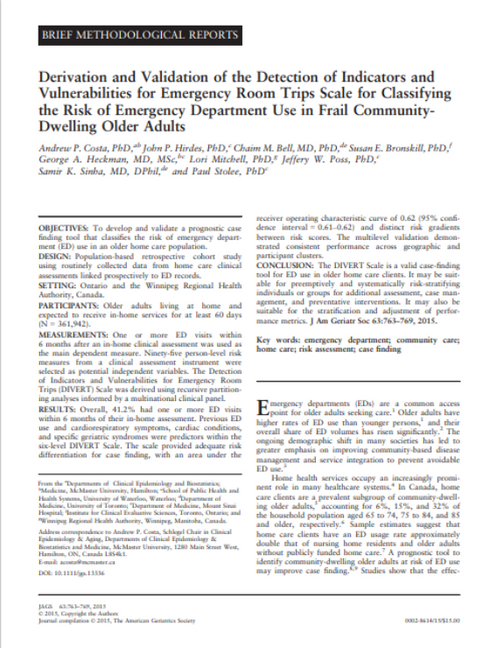Derivation and Validation of the Detection of Indicators and Vulnerabilities for Emergency Room Trips Scale for Classifying the Risk of Emergency Department Use in Frail Community Dwelling Older Adult
The purpose of this research was to develop and validate a prognostic case finding tool that classifies the risk of emergency department (ED) use in an older home care population.
Author: Andrew P. Costa, PhD, John P. Hirdes, PhD, Chaim M. Bell, MD, PhD, Susan E. Bronskill, PhD, George A. Heckman, MD, MSc, Lori Mitchell, PhD, Jeffery W. Poss, PhD, Samir K. Sinha, MD, DPhil, Paul Stolee, PhD
Publication Date: 2015
Description:
Objectives: To develop and validate a prognostic case finding tool that classifies the risk of emergency department (ED) use in an older home care population.
Design: Population-based retrospective cohort study using routinely collected data from home care clinical assessments linked prospectively to ED records.
Setting: Ontario and the Winnipeg Regional Health Authority, Canada.
Participants: Older adults living at home and expected to receive in-home services for at least 60 days (N = 361,942).
Measurements: One or more ED visits within 6 months after an in-home clinical assessment was used as the main dependent measure. Ninety-five person-level risk measures from a clinical assessment instrument were selected as potential independent variables. The Detection of Indicators and Vulnerabilities for Emergency Room Trips (DIVERT) Scale was derived using recursive partitioning analyses informed by a multinational clinical panel.
Results: Overall, 41.2% had one or more ED visits within 6 months of their in-home assessment. Previous ED use and cardiorespiratory symptoms, cardiac conditions, and specific geriatric syndromes were predictors within the six-level DIVERT Scale. The scale provided adequate risk differentiation for case finding, with an area under the receiver operating characteristic curve of 0.62 (95% confidence interval = 0.61-0.62) and distinct risk gradients between risk scores. The multilevel validation demonstrated consistent performance across geographic and participant clusters.
Conclusion: The DIVERT Scale is a valid case-finding tool for ED use in older home care clients. It may be suitable for preemptively and systematically risk-stratifying individuals or groups for additional assessment, case management, and preventative interventions. It may also be suitable for the stratification and adjustment of performance metrics.
Access: Free
Keywords: emergency department, community care, home care, risk assessment, case finding, case mangement



